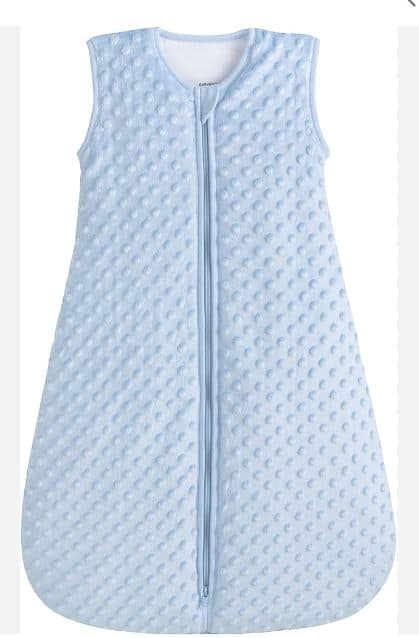Are you a new parent searching for the perfect sleeping bag to keep your newborn cozy and comfortable? Look no further. In this essential guide, we will walk you through everything you need to know to choose the ideal sleeping bag for your little one.
Finding the right sleeping bag for your newborn is of utmost importance. Not only does it provide a safe and secure sleeping environment, but it also promotes better sleep, allowing your baby to rest peacefully through the night.
In this comprehensive guide, we will cover all the key factors to consider when selecting a sleeping bag, including size, materials, temperature ratings, and safety features. We will also provide helpful tips and insights to ensure you make an informed decision.
Whether you’re looking for a lightweight option for summer or a cozy bag for winter, this guide has got you covered. Our expert advice and recommendations will help you find the perfect sleeping bag to keep your newborn snug and content.

Say goodbye to sleepless nights and hello to restful slumbers for you and your precious bundle of joy. Let’s get started on this journey to finding the perfect sleeping bag for your newborn.
Importance of choosing the right sleeping bag for your newborn
Finding the right sleeping bag for your newborn is of utmost importance. Not only does it provide a safe and secure sleeping environment, but it also promotes better sleep, allowing your baby to rest peacefully through the night.
Newborns have delicate skin and regulating their body temperature is essential for their well-being. A well-designed sleeping bag can help maintain a comfortable temperature, preventing overheating or chilling. It also eliminates the risk of loose blankets covering your baby’s face, reducing the risk of suffocation.
Additionally, a good sleeping bag can provide a sense of security for your little one. The enclosed space mimics the feeling of being in the womb, helping them feel calm and settled. This promotes a deeper and more restful sleep, which is beneficial for their growth and development.
Understanding different types of sleeping bags
Before diving into the factors to consider when choosing a sleeping bag for your newborn, let’s understand the different types available in the market.
- Swaddle sleeping bags: These are specially designed for newborns and mimic the feeling of being swaddled. They have a snug fit around the arms and torso, providing a sense of security for your baby.
- Traditional sleeping bags: These are designed for older infants and toddlers. They have armholes and a zipper to allow easy access for diaper changes. Traditional sleeping bags provide more freedom of movement for older babies.
- Sleeping bags with detachable sleeves: These are versatile options that can be used in various weather conditions. The detachable sleeves allow you to adjust the warmth of the sleeping bag according to the temperature.
Factors to consider when choosing a sleeping bag for your newborn
Now that you have an idea of the different types of sleeping bags available, let’s explore the key factors to consider when choosing the perfect one for your newborn.
- Size: It’s crucial to select the right size sleeping bag for your newborn. A bag that is too big may pose a safety risk, while one that is too small will be uncomfortable for your baby. Most sleeping bags come in sizes based on your baby’s weight or age, so be sure to check the sizing guide provided by the manufacturer.
- Materials: The materials used in the sleeping bag play a significant role in your baby’s comfort. Look for sleeping bags made from soft and breathable fabrics such as cotton or bamboo. These materials help regulate your baby’s body temperature and prevent overheating.
- Temperature ratings: Sleeping bags often come with temperature ratings to guide you in choosing the right bag for different seasons. It’s essential to consider the average room temperature and dress your baby appropriately for sleep. A tog rating is commonly used to indicate the warmth of a sleeping bag, with lower tog ratings suitable for warmer weather and higher tog ratings for colder temperatures.
- Ease of use: As a new parent, convenience is key. Look for sleeping bags with easy-to-use zippers or buttons that allow quick diaper changes during the night. Some sleeping bags also have a two-way zipper, which enables you to open the bottom for ventilation or to accommodate a car seat buckle.
- Design and features: Consider the overall design of the sleeping bag. Look for features like a secure neck and armhole openings that prevent your baby from slipping inside the bag. Also, check for reinforced stitching, quality closures, and a well-fitting neck and armholes to ensure your baby’s safety and comfort.
Safety features to look for in a newborn sleeping bag
Safety should be your top priority when choosing a sleeping bag for your newborn. Here are some key safety features to look for:
- Secure neck and armhole openings: Ensure that the sleeping bag has snug neck and armhole openings to prevent your baby from slipping inside the bag. The openings should be appropriately sized to prevent suffocation risks.
- No loose or detachable parts: Avoid sleeping bags with loose or detachable parts, such as ribbons or buttons, as they can pose a choking hazard. Opt for sleeping bags with secure closures and minimal embellishments.
- Fire safety standards: Check if the sleeping bag complies with fire safety standards. Look for labels or certifications indicating that the bag meets the necessary safety requirements.
- Proper fit: The sleeping bag should fit your baby properly, with no excess fabric that could cover their face and obstruct breathing. Follow the manufacturer’s guidelines for sizing and ensure that your baby’s head cannot slip through the neck opening.
- Breathable fabrics: Choose sleeping bags made from breathable fabrics to prevent overheating and ensure air circulation. Avoid synthetic materials that can trap heat and moisture.
How to Dress Your Newborn for Sleep in a Sleeping Bag
When it comes to dressing your newborn for sleep in a sleeping bag, it’s important to strike the right balance between keeping them warm and ensuring they don’t overheat. Here are some helpful tips to guide you:
- Consider the temperature: The temperature of the room plays a crucial role in determining how you dress your newborn for sleep. If the room is warm, opt for a lightweight sleeping bag and dress your baby in a light onesie or a short-sleeved bodysuit. If the room is cooler, choose a slightly thicker sleeping bag and layer your baby’s clothing accordingly.
- Choose the right size: Ensure that the sleeping bag you select is the appropriate size for your newborn. A bag that is too big can pose safety risks, while one that is too small may restrict movement and cause discomfort. Most sleeping bags come with age or weight guidelines to help you make the right choice.
- Consider the season: Different seasons require different sleeping bag options. For warmer months, look for sleeping bags made from breathable fabrics such as cotton or bamboo. These materials help regulate your baby’s body temperature and prevent overheating. In colder months, opt for bags with additional insulation or a tog rating suitable for cooler temperatures.
- Layering: Layering is key to keeping your newborn comfortable throughout the night. Start with a light base layer, such as a onesie or bodysuit, and add a layer of warmth with a sleep sack or a swaddle blanket. This allows you to easily adjust the level of warmth based on the room temperature.
- Safety first: Always prioritize safety when dressing your newborn for sleep. Avoid using loose blankets or pillows in the sleeping bag as they can pose suffocation hazards. Opt for sleeping bags with secure fastenings and ensure that they fit snugly around your baby’s neck and arms to prevent them from slipping inside the bag.
Remember, every baby is different, and what works for one may not work for another. Pay attention to your baby’s cues and adjust their clothing accordingly. Now that you have a better understanding of how to dress your newborn for sleep in a sleeping bag, let’s move on to exploring the key factors to consider when choosing the perfect sleeping bag.
